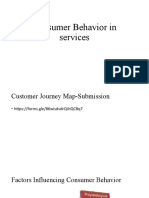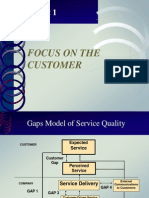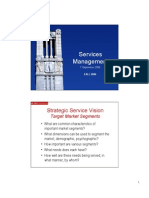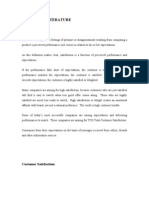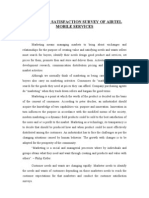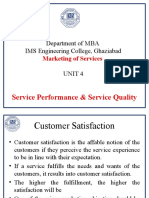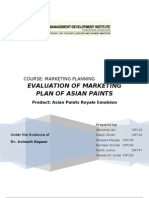Lesson-2-4 Consumer Behavior in Services
Lesson-2-4 Consumer Behavior in Services
Uploaded by
Muhammad Akmal HussainCopyright:
Available Formats
Lesson-2-4 Consumer Behavior in Services
Lesson-2-4 Consumer Behavior in Services
Uploaded by
Muhammad Akmal HussainOriginal Description:
Copyright
Available Formats
Share this document
Did you find this document useful?
Is this content inappropriate?
Copyright:
Available Formats
Lesson-2-4 Consumer Behavior in Services
Lesson-2-4 Consumer Behavior in Services
Uploaded by
Muhammad Akmal HussainCopyright:
Available Formats
LESSON-2
CONSUMER BEHAVIOR IN SERVICES
Evaluation Continuum
Most goods
Most services
EASY
DIFFICULT
High in Search Quality
High in Experience Quality
High in Credence Quality
CONSUMER DECISION MAKING
Information Search
Use of personal sources Evaluation of Alternatives Evoked set
Perceived risk
Emotion & mood
Purchase & Consumption
Service provision as drama Service roles and scripts Compatibility of customers
Post Purchase Evaluation
Attribution of dissatisfaction Innovation diffusion Brand loyalty
Differences in Decision Making
Information Search
Use of personal Source Perceived Risk Evoked set Emotion & Mood
Evaluation of Alternatives
Purchase and Consumption Post Purchase Evaluation
Information Search
Use of Personal Sources:- seek & rely more
Media more info about search qualities , little about experiences Media may not be available, Joint promo and banned professional ads Few attributes before purchase; feel more risk
Intangible nature of services Services are non-std, few give warranties Tech services for which consumer has no knowledge Strategies: Guarantees of satisfaction and empl skills
Perceived Risk
Evaluation of Service Alternatives
Evoked Set
Smaller in services than in goods Retailing vs banks, dry cleaning Few business suppliers in services as compared to goods Adequate pre-purchase info lacking Nonprofessional services Faced with this task of collecting and evaluating experiences consumers may simply select the first available alternative rather than searching for many
Purchase & Consumption
Emotion and Mood:- Both are feeling states but moods are distinguished from emotions in that moods refer to transient state whereas emotions are more intense, stable and pervasive
Services are experiences, therefore both are critical factors that shape the perceived effectiveness of the service encounters. Related to behavior of a customer; provider and others
Positive moods can make customers more obliging and vice versa The direction of the bias in evaluation is consistent with polarity Moods and emotions are linked with memories.
Service marketers should attempt to influence these moods and emotions in positive ways. They need to cultivate positive moods such as joy , delight and contentment and shall discourage distress, frustration, anger and disgust.
Purchase & Consumption
Service provision as drama
Services roles and script
Both create and maintain a desirable impression Carefully managing the actors and physical setting of their behavior Skill of the actors because more contact Physical setting of the service which includes atmosphere, smell, use of space, the style, design and cleanliness
Customers and service providers roles and performance according to desired level Coherent sequence of events Incompatible in many aspects such as beliefs, values, experiences, age, ability to pay, health etc Customers influence on others experiences
The compatibility of customers
Post Purchase Dissatisfaction
Attribution Of Dissatisfaction
Both share the responsibility Dr diagnosis based on patient briefing Info of services diffuse slowly due to these five characteristics:
Innovation Diffusion
Perception of relative advantage, compatibility, communicability, divisibility and complexity
Adoption of services is more slow than goods
Marketers shall concentrate on incentives to trial Brand Loyalty:- switching cost, risk, substitute and level of satisfaction in the past.
Loyal customers in services stay longer Switching cost e.g. changing hospital; health club membership fee Competitors loyal customers switching will require attacking on competitors weak areas.
CONSUMER DECISION MAKING
Information Search
Use of personal sources Perceived risk CULTURE
Values & Attitude Religion and Language Manners & customs Material culture Aesthetics Educational & Social institution
Evaluation of Alternatives Evoked set Emotion & mood
Cultural Universals
Purchase & Consumption
Service provision as drama Service roles and scripts Compatibility of customers
Post purchase Evaluation
Attribution of dissatisfaction Innovation diffusion Brand loyalty
CULTURE
A configuration of learned behavior and results are shared by members of a society. Its importance in services is much more than in goods. Evaluation and interaction . The sum total of learned beliefs, values and customs that serve to direct consumer behavior in a particular market:
Beliefs : A large number of mental &verbal processes reflect our knowledge and assessment of product and services. Values: The indicators consumers use to serve as guides for what is appropriate behavior.Relatively enduring and stable Customs: Overt modes of behavior that culturally approved or acceptable ways of behaving in specific situations, Births, Marriages e.t.c.
CULTURE INFLUENCES ON BUYER BEHAVIOUR
CULTURAL FORCES CULTURAL MESSAGE
RELIGION HISTORY FAMILY LANGUAGE EDUCATION ARTS
SYMBOLS MORALS KNOWLEDGE RULES OF BEHAVIORS
CONSUMER DECISION PROCESS
SELECTING PRIORITISING WANTS DECISION MAKING
Chapter -3
Customers Expectations of Service
Service Expectations
Two levels of expectations
The zone of tolerance Different customers possess different zone of tolerance Zone of tolerance vary for service dimensions Zone of tolerance vary for first-time and recovery service Sources of desired service expectations Sources of adequate service expectations Service encounter expectations verses overall service expectations Sources of both desired and predicted service expectations
Factors that influence customers expectations of service
Dual Customer Expectation Level
Desired Service
Level of service hope to receive or Wished for level of performance
Level of service the customer will accept or minimum tolerable expectations Adequate Service
The Zone Of Tolerance (Z of T)
Delighted
Desired Service
Zone of Tolerance
Acceptance of variations in the service level
Adequate Service
Unaccepted level- dissatisfaction
Zones Of Tolerance For Different Service Dimensions
Desired service
Level of Expectation
Zone of Tolerance
Desired service
Adequate Service
Zone Of Tolerance
Adequate Service
Most Important Factors
Least Important Factors
Z of T for First Time & Recovery Service
First Time Service
Outcome Process
Recovery Service
Outcome Process Low
Expectations
High
Factors That Influence Desired Service
Derived service expectation
Personal service philosophy
EXPECTED SERVICE
Enduring service intensifiers
Desired Service
Personal needs
Zone Of Tolerance
Adequate Service
Many expectations are formed by uncontrollable factors due to customers experience with other coys & edu, values
Factors That Influence Adequate Service
Transitory service intensifiers
Desired Service
Perceived service alternatives Zone Of Tolerance
Self-perceived Service role Adequate service Situational factors Predicted Service
Factors that influence desired and predicted service
Explicit service promises EXPECTED SERVICE
Implicit service promises
Desired Service
Word of mouth
Zone Of Tolerance
Past experience
Adequate Service
Predicted Service
Nature And Determinants Of Customer Expectations Of Service
ENDURING SERVICE INTENSIFIERS Derived expectations Personal service Philosophies PERSONAL NEEDS EXPLICT SERVICE PROMISES
Advertising Personal selling Contracts Other communications
IMPLICIT SERVICE PROMISES
TRANSITORY SERVICE INTENSIFIERS
Tangibles Price EXPECTED SERVICE Desired Service Zone Of Tolerance Adequate Service Gap 5
PERCEIVED SERVICE WORD OF MOUTH
Emergencies Service problems
PERCEIVED SERVICE ALTERNATIVES
Personal Expert (Consumer Reports, publicity, Consultants,surrogates
PAST EXPERIENCE
SELF-PERCEIVED SERVICE ROLE
PREDICTED SERVICE
SITUATIONAL FACTORS Bad weather Catastrophe Random over demand
Current Issues
What does a service marketer do if customers are unrealistic? How does a company exceed customer service expectations? Do customer service expectations continually escalate? How does a service company stay ahead of competition in meeting customer expectations?
Chapter -4 CUSTOMER PERCETIONS OF SERVICE
PERCEPTIONS OF SRVICE
Customer Perception Customer perceived services in terms of the quality of the service and how satisfied they are overall with their experience Satisfaction versus Service quality Two concepts are different Perceived service quality is part of customer satisfaction Health club service facility vs broader concept of service perception Internal and external Customer Perception Customer Satisfaction Satisfaction is the customers fulfillment response. It is a judgment that a product or service feature or the product or service itself provides a pleasurable level of consumption-related fulfillment. Or we can say that whether the customers evaluation of a product or service has met their needs and expectations. Product and service feature trade off. Customer Emotions positive and negative affect perception of satisfaction. Attribute for service success or failure Perceptions of Equity or Fairness ACSI results are:- non-durables- satisfied, durable-less satisfied and services- least satisfied
Customer Perceptions Of Quality & Customer Satisfaction
Reliability
Responsiveness Assurance Empathy Tangibles Product quality
Service quality
Situational Factors Satisfaction Customer
Price
Personal factors
Customer Satisfaction & Loyalty
Profitability
100
Loyalty Retention %
0 1
Very unsatisfied
2 Dissatisfied
3
Neither or nor
4
satisfied
5
Very satisfied
Satisfaction Measure
Service Quality Dimensions
Reliability Responsiveness Assurance Empathy Tangibles
Customer perceptions of quality & customer satisfaction
Reliability Responsive
Service quality Product quality
Situational Factors
Assurance
Empathy
Customer Satisfaction
Personal factors
Tangibles
Price
Service Encounters or Moments of Truth
When the customer interacts with service firm e.g. hotel customer Some services have few encounters while others have many. Some of the encounters are very critical in developing customer loyalty and generally are the first few. When a customer had a multiple interactions with a firm, each encounter will create a composite image in customers mind. Not all encounters are equally important in services in building relationship. Momentous encounters ruin the rest and drive customer away like a proverbial one bad apples simply ruins the rest. Real time marketing where promises are kept or broken Three general type; remote; phone and face to face encounters.
A service encounter cascade for an industrial purchase
Sales Call
Delivery and Installation
Servicing
Ordering of Supplies
Billing
A service encounter cascade for a hotel visit
Check-In Bell person Takes to Room
Restnaurat Meal
Wake Up Call
Check Out
Sources Of Pleasure And Displeasure
Recovery :- Employee response to service delivery system failures Adaptability:- Employee response to customer needs and request Spontaneity :- unprompted and unsolicited employee actions Coping :- Employee response to Problem customers
Evidence of Service( customer)
Contact Employee Customer him/herself Other customers
Operation flow of activities Steps in process Flexibility versus standard Technology versus human
Tangible Communication Servicescape Guarantees Technology
Strategies For Influencing Customer Perception
Measure and manage CS & SQ Aim for CQ & CS in very service encounter
Plan for effective recovery Facilitate adaptability and flexibility Encourage Spontaneity Help Employees cope with problem customers Manage the dimensions of quality at the Encounter level
Manage the evidence of service to reinforce perceptions
You might also like
- Brand Love - Michael, LydiaDocument233 pagesBrand Love - Michael, LydiarauldieguesNo ratings yet
- Services Marketing: Consumer Behavior in Services Unit 2Document78 pagesServices Marketing: Consumer Behavior in Services Unit 2mpsrishaNo ratings yet
- Harvard Business Review on Increasing Customer LoyaltyFrom EverandHarvard Business Review on Increasing Customer LoyaltyRating: 4 out of 5 stars4/5 (1)
- Business Economics Chapter 2 - Demand AnalysisDocument44 pagesBusiness Economics Chapter 2 - Demand Analysissharukh kapadiaNo ratings yet
- Microeconomics Notes by DR Idrees QAU IslamabadDocument142 pagesMicroeconomics Notes by DR Idrees QAU IslamabadAtiq100% (2)
- Consumer Behaviour in ServicesDocument15 pagesConsumer Behaviour in Servicessahana_pradeep8726No ratings yet
- Unit 2Document26 pagesUnit 2sarkctNo ratings yet
- Service MarketingDocument29 pagesService MarketingRisha Rakshit100% (1)
- The Customer Gap Is The Difference Between Customers Expectations and Perception. - It Helps The Company To Understand The Customer SatisfactionDocument81 pagesThe Customer Gap Is The Difference Between Customers Expectations and Perception. - It Helps The Company To Understand The Customer Satisfaction22PBA136 HARIHARAN SNo ratings yet
- Gap ModelDocument109 pagesGap ModelChanchal Kansal50% (2)
- Consumer Behavior in ServicesDocument50 pagesConsumer Behavior in ServicesMangesh KandalgaonkarNo ratings yet
- Gap ModelDocument21 pagesGap ModelAravind Sai PrasadNo ratings yet
- Chapter 3. Service Delivery & Quality ManagementDocument46 pagesChapter 3. Service Delivery & Quality ManagementNity NiharikaNo ratings yet
- Consumer Behavior in ServicesDocument65 pagesConsumer Behavior in Services121923602032 PUTTURU JAGADEESHNo ratings yet
- Chapter FourDocument8 pagesChapter FourkasyegezeNo ratings yet
- Consumer Behaviour in ServicesDocument22 pagesConsumer Behaviour in ServicesGurinder SinghNo ratings yet
- Customer Expectations of ServiceDocument24 pagesCustomer Expectations of ServiceManoj Dongare100% (2)
- Consumer Behaviour in Services PDFDocument21 pagesConsumer Behaviour in Services PDFVanshiiNo ratings yet
- Focus On The CustomerDocument13 pagesFocus On The CustomerVineeth ViswanathNo ratings yet
- Marketing of Services: Unit 2, Lecture - Customer Expectations and Perceptions of ServicesDocument16 pagesMarketing of Services: Unit 2, Lecture - Customer Expectations and Perceptions of ServicesPriya SinghNo ratings yet
- Customer SatisfactionDocument19 pagesCustomer SatisfactionPankaj DograNo ratings yet
- Understanding Services CustomerDocument15 pagesUnderstanding Services CustomerAby Reji ChemmathuNo ratings yet
- Service QualityDocument14 pagesService Qualitywangechinjoroge.jNo ratings yet
- Service MarketingDocument43 pagesService Marketingshobuj pathanNo ratings yet
- LESSON 2-4 Consumer Behavior in ServicesDocument37 pagesLESSON 2-4 Consumer Behavior in ServicesSaadNo ratings yet
- Focus On The CustomerDocument11 pagesFocus On The Customerimran20bestNo ratings yet
- Services Management: Strategic Service VisionDocument13 pagesServices Management: Strategic Service VisionRimsee ChhajerNo ratings yet
- Service Marketing: Prachi DivekarDocument31 pagesService Marketing: Prachi DivekarPrachi DivekarNo ratings yet
- Unit 2Document142 pagesUnit 2Jatinder KaurNo ratings yet
- Services Marketing 2 - Consumer Behavior in ServicesDocument50 pagesServices Marketing 2 - Consumer Behavior in ServicesAnkapa Naidu DamaNo ratings yet
- 4ba9cmodule 2-Part1 PDFDocument55 pages4ba9cmodule 2-Part1 PDFAditya ChoudharyNo ratings yet
- Final Document India MartDocument63 pagesFinal Document India MartJOSE SELVINNo ratings yet
- Review of Literature: SatisfactionDocument10 pagesReview of Literature: SatisfactionKing KrishNo ratings yet
- Customer Satisfaction in Kancheepuram 2003Document11 pagesCustomer Satisfaction in Kancheepuram 2003Shano InbarajNo ratings yet
- Customer Satisfaction Survey of Airtel Mobile Services: MarketingDocument68 pagesCustomer Satisfaction Survey of Airtel Mobile Services: MarketingMohan KmksNo ratings yet
- THC2 Hospitality ManagementDocument25 pagesTHC2 Hospitality ManagementGranale, Marielle Faith M.No ratings yet
- AbstractDocument46 pagesAbstractArpit CmNo ratings yet
- Customer Expectations of ServicesDocument21 pagesCustomer Expectations of ServicesAanchal Gupta100% (2)
- Title of The Paper: Sales and Distribution ManagementDocument3 pagesTitle of The Paper: Sales and Distribution ManagementAmith MashimadeNo ratings yet
- This Study On Customer Satisfaction and Service QuDocument5 pagesThis Study On Customer Satisfaction and Service Qudesuadmas68No ratings yet
- Unit 2-6Document14 pagesUnit 2-6aniketguhe39No ratings yet
- Service MarketingDocument37 pagesService MarketingSachin MethreeNo ratings yet
- Service Performance & Service Quality: Department of MBA IMS Engineering College, GhaziabadDocument30 pagesService Performance & Service Quality: Department of MBA IMS Engineering College, GhaziabadMohit RuhalNo ratings yet
- Service Performance & Service Quality: Department of MBA IMS Engineering College, GhaziabadDocument30 pagesService Performance & Service Quality: Department of MBA IMS Engineering College, GhaziabadMohit Ruhal100% (1)
- Service Performance & Service Quality: Department of MBA IMS Engineering College, GhaziabadDocument30 pagesService Performance & Service Quality: Department of MBA IMS Engineering College, GhaziabadMohit RuhalNo ratings yet
- Lesson 1 Quality Service DefinedDocument5 pagesLesson 1 Quality Service DefinedAnnie Claire VisoriaNo ratings yet
- Getrude - Research Methods - Assignment 1Document10 pagesGetrude - Research Methods - Assignment 1cpaahmadomarNo ratings yet
- Wa0004.Document14 pagesWa0004.patelgulshan9621No ratings yet
- Customer Satisfaction and Service QualityDocument41 pagesCustomer Satisfaction and Service QualityChetas PatilNo ratings yet
- SM Unit 1 & 2Document151 pagesSM Unit 1 & 2manjunathNo ratings yet
- Lesson 4 Customer Satisfaction SMDocument4 pagesLesson 4 Customer Satisfaction SMRICARDO JIMENEZNo ratings yet
- Service Marketing Final 29102012Document73 pagesService Marketing Final 29102012Prateek Maheshwari100% (1)
- Service Consumer Behavior SESSION-5.1Document10 pagesService Consumer Behavior SESSION-5.1Swarnalata DashNo ratings yet
- Service MarketingDocument73 pagesService MarketingSuvigya LalNo ratings yet
- Consumer Behavior in ServicesDocument22 pagesConsumer Behavior in ServicesViswajeet BiswalNo ratings yet
- Services MarketingDocument33 pagesServices MarketingVishal VishNo ratings yet
- 3 Gaps ModelDocument24 pages3 Gaps Modelapi-3716588100% (4)
- UNIT.2 Service Consumer BehaviorDocument40 pagesUNIT.2 Service Consumer BehaviorKiran SoniNo ratings yet
- Relationship Marketing & Recovery Management: Dr. Hersh SharmaDocument18 pagesRelationship Marketing & Recovery Management: Dr. Hersh SharmaRaj JadavNo ratings yet
- Service Gap Model & Service QualityDocument16 pagesService Gap Model & Service QualityAntony Deric CostaNo ratings yet
- Measuring Customer Satisfaction: Exploring Customer Satisfaction’s Relationship with Purchase BehaviorFrom EverandMeasuring Customer Satisfaction: Exploring Customer Satisfaction’s Relationship with Purchase BehaviorRating: 4.5 out of 5 stars4.5/5 (6)
- Final Newsletter Karwan e HayatDocument4 pagesFinal Newsletter Karwan e HayatMuhammad Akmal HussainNo ratings yet
- METRO Supply ChainDocument28 pagesMETRO Supply ChainMuhammad Akmal HussainNo ratings yet
- Service Development and DesignDocument15 pagesService Development and DesignMuhammad Akmal HussainNo ratings yet
- Workplace Bullies: Case Study 2Document16 pagesWorkplace Bullies: Case Study 2Muhammad Akmal HussainNo ratings yet
- Uni FerozDocument19 pagesUni FerozMuhammad Akmal HussainNo ratings yet
- Microeconomics ConceptDocument5 pagesMicroeconomics ConceptMuhammad Akmal HussainNo ratings yet
- Chapter 10 - CommunicationDocument19 pagesChapter 10 - CommunicationMuhammad Akmal Hussain100% (1)
- Gallo WineryDocument43 pagesGallo WineryMuhammad Akmal HussainNo ratings yet
- Gallo WineryDocument43 pagesGallo WineryMuhammad Akmal HussainNo ratings yet
- Zaira CVDocument1 pageZaira CVMuhammad Akmal HussainNo ratings yet
- MarkovDocument11 pagesMarkovMuhammad Akmal HussainNo ratings yet
- Elasticity CorrectDocument4 pagesElasticity CorrectMuhammad Akmal HussainNo ratings yet
- 9.leasing or IjaraDocument31 pages9.leasing or IjaraMuhammad Akmal HussainNo ratings yet
- Consumer BehaviourDocument15 pagesConsumer Behaviourkapooraishna4915No ratings yet
- Chapter 2Document26 pagesChapter 2Divya HarshiniNo ratings yet
- Case Study-Lux: Jainam Shah Deepak Parwani Uday Vir Singh Rana Deepanwita Burman Harshida Punjabi Roshna Ashish PrasadDocument21 pagesCase Study-Lux: Jainam Shah Deepak Parwani Uday Vir Singh Rana Deepanwita Burman Harshida Punjabi Roshna Ashish PrasadUday Vir Singh RanaNo ratings yet
- Chapter 5 - Part 2 SolutionsDocument5 pagesChapter 5 - Part 2 SolutionsdylanNo ratings yet
- Schiffman cb11 Im02Document23 pagesSchiffman cb11 Im02Perihan SalahNo ratings yet
- 1, Demand AnalysisDocument31 pages1, Demand AnalysisÎßhû ẞhåñdèlNo ratings yet
- Econ - Unit - 2 - Consumer Demand TheoryDocument36 pagesEcon - Unit - 2 - Consumer Demand TheorySampurnaa DasNo ratings yet
- Unit 6-1Document38 pagesUnit 6-1Mubin Shaikh NooruNo ratings yet
- The Implications of Globalisation For Consumer AttitudesDocument2 pagesThe Implications of Globalisation For Consumer AttitudesIvan Luis100% (1)
- Journal of Hospitality and Tourism Management: Jongsik Yu, Kyeongheum Lee, Sunghyup Sean HyunDocument9 pagesJournal of Hospitality and Tourism Management: Jongsik Yu, Kyeongheum Lee, Sunghyup Sean HyunMuhamad Amiruddin HusniNo ratings yet
- Digital Marketing Assignment Week 4Document8 pagesDigital Marketing Assignment Week 4Olivia SandyNo ratings yet
- Project On Cinthol SoapDocument56 pagesProject On Cinthol SoapRoyal Projects67% (12)
- Chapter - I: 1.1 Project ProfileDocument16 pagesChapter - I: 1.1 Project ProfileRAMAKRISHNANNo ratings yet
- (CB) L6 - Judgment and Decision MakingDocument37 pages(CB) L6 - Judgment and Decision MakingNHI NGUYỄN TRẦN YẾNNo ratings yet
- Marketing Plan of Asian Paints Group4Document58 pagesMarketing Plan of Asian Paints Group4kandysuchak25% (4)
- Demand Analysis and Optimal PricingDocument32 pagesDemand Analysis and Optimal PricingHerrah Joyce SalinasNo ratings yet
- CosmeticDocument22 pagesCosmeticPooja MaheshwariNo ratings yet
- Marketing Mids Notes by MadKingDocument15 pagesMarketing Mids Notes by MadKingAhmed SaeedNo ratings yet
- Understanding Buyer BehaviorDocument26 pagesUnderstanding Buyer BehaviorAbdou DarboeNo ratings yet
- DM ch.2Document57 pagesDM ch.2Tala MomaniNo ratings yet
- The Strategic Value of Regression Analysis in MarketingDocument9 pagesThe Strategic Value of Regression Analysis in MarketingsnwareresearchNo ratings yet
- Problem Set 1 - SOLUTIONS ECH-32306 Advanced Microeconomics, Part 1, Fall 2016Document6 pagesProblem Set 1 - SOLUTIONS ECH-32306 Advanced Microeconomics, Part 1, Fall 2016Adriana SenaNo ratings yet
- Understanding and Predicting Electronic Commerce Adoption An Extension of The Theory of Planned BehaviorDocument30 pagesUnderstanding and Predicting Electronic Commerce Adoption An Extension of The Theory of Planned BehaviorJingga NovebrezaNo ratings yet
- MODERN SCHOOL Assignment EconomicsDocument2 pagesMODERN SCHOOL Assignment EconomicsP Janaki RamanNo ratings yet
- Manuscript of Group 3 in ResearchDocument27 pagesManuscript of Group 3 in ResearchSarah Real RodriguezNo ratings yet
- Topic AllDocument65 pagesTopic AllJamila KhatoonNo ratings yet
- MDI GURGAON 37039193 Marketing Plan of Asian Paints Group4Document58 pagesMDI GURGAON 37039193 Marketing Plan of Asian Paints Group4arushpratyushNo ratings yet













